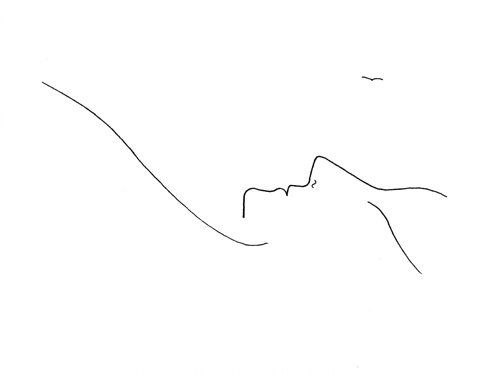DESPUÉS, EL VIENTO (After, the Wind)
1984. Pencil on paper. 12.5x7.5 cm.
[This drawing was selected by the author for the cover illustration of his book El Zócalo, the first volume of the tetralogy Cortejo y Epinicio, in which each volume corresponds, among other subjects, to an age of man. El Zócalo (The Plinth) takes place at the time of childhood and adolescence.]
The mouth is slightly open. This angle, widened, repeats itself in the shape of the bird suspended above the profile. What is poetry if not the revelation of thought, giving flight to poetic words?
No eye, only an eyebrow that indicates an inner vision, indispensable to understanding the outer realm.
The ascending/descending curved line below the chin: a mound. Is this individual buried? He is dead and alive, asleep and awake, in the past and in the present, young and mature, profoundly reflecting from a vantage point that allows him to achieve a vast comprehension of reality. This line goes all the way to his throat or rises from it: he absorbs the outer world in order to bear witness to it. The outline of the mound echoes the form of the eyebrow and a wing of the bird. The face is not attached to anything: it is airborne too, as are all the elements in the drawing.
The nostril discreetly indicates the possible presence of breath. It also echoes the shape of the bird. There is a movement toward this personage and away from him.
The profile brings to mind a mountain landscape above which a bird hovers. The eyebrow is a path leading to the top of a mountain: an outer and inner landscape.
Variations of the bird outline can be found throughout the drawing, even in the wide angle formed by the forehead and the nose. This repetition gives importance to the bird: what is small is big and what is big is small.
Nothing is obvious in all these correspondences of shapes. They resemble each other but they are not the same, so the design as a whole appears natural. Even if the viewer does not notice the detailed subtleties, he may grasp — guided without being conscious of it — the artist's intentions.
This character does not belong to any country in particular or belongs to all of them. Beyond cultural particularities, real poetry goes only to what is essential.
[“He” has been used throughout this text for convenience, but it is obvious that this figure is neither masculine nor feminine per se.]


